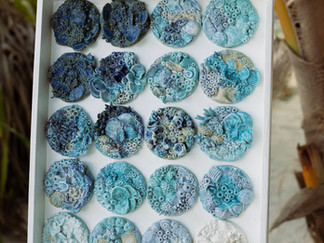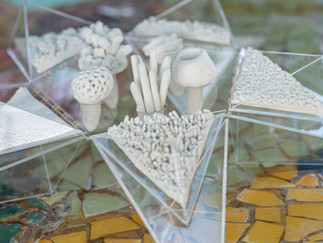Art Consultant Tatiana Gecmen-Waldek On Imagi-Nature Art Festival & JOALI Maldives
- Sasha Huang
- Jul 9, 2023
- 6 min read
INTERVIEW

Situated on a private island in the middle of the Indian Ocean, JOALI Maldives beckons as an unparalleled escape for the discerning traveller. Beyond its refined elegance, this esteemed resort stands as a staunch advocate for environmental stewardship, proudly supporting initiatives like the Olive Ridley Project and esteemed foundations.
Enter the world of Tatiana Gecmen-Waldek, an art consultant and captivating audio storyteller, whose journey spans from the captivating allure of Austria to the artistic vibrance of Paris. With an illustrious portfolio boasting collaborations with renowned brands like Giorgio Armani, Cartier, and Maison Kitsuné, Gecmen-Waldek's artistic vision intertwines effortlessly with JOALI Maldives, culminating in the extraordinary Imagi-Nature Art Festival.
From the 14th to the 18th of April, with World Art Day gracing the 15th, this extraordinary event propelled guests into a realm where sustainability and boundless creativity merged. Each art installation, meticulously crafted from recycled waste, clay, or other natural materials, weaves a narrative against a backdrop of unspoiled beauty. We chat to Gecmen-Waldek on her career, inspirations and what art means today.

1. How would you describe your childhood and upbringing and how has this influenced who you are today?
I am half French and half Austrian with quite a strong Mitel Europa influx. I grew up in Tehran before the revolution and then in Paris where I went to school. We travelled a lot. Our family is scattered around the world which makes us multi-cultural and curious to say the least. Growing up in different countries and cultures made me more open-minded and adaptable to change. Exposure to art and different forms of creativity can also foster a love for exploring new ideas and perspectives. These experiences contributed to my sense of curiosity and appreciation for diversity. At an early age, my father would drag me to exhibitions, museums, artists studios and at age 14, I ventured alone to the Parisian contemporary art fair La Fiac (now Paris+ Art Basel) which led me to become a huge fan of contemporary and emerging art to such an extend that a bit later I even dated a gallerist but not for very long :)
2. What do you think is the most exciting part about being an art consultant?
Being an art consultant allows you to work with a diverse group of people, including contemporary artists, collectors, and corporate clients. The opportunity to exchange ideas and collaborate with these individuals can be one of the most exciting parts of the job. It can be fulfilling to support artists realise their vision and connect collectors with works of art that can compliment their collection. I must balance creative vision with practical considerations, such as budget and client needs. This can require a lot of strategic thinking, problem-solving, and negotiation skills. It can also be rewarding to see the impact of my work, whether it's through the successful sale of an artwork, the creation of an unexpected corridor in their collection or a one-of-a-kind collaboration. As an art consultant, I am motivated to stay up-to-date with the latest trends and developments in the art world. This can involve attending art fairs, exhibitions, festivals, which can be exciting opportunities for exchange and exploration. What excites me the most is to be involved in the creation and acquisition of art that can have a significant impact on people's lives.

"What excites me the most is to be involved in the creation and acquisition of art that can have a significant impact on people's lives."

3. How do you make art interact with space, and with the audience?
With the artist I collaborate with, we often use a variety of strategies to create an engaging and interactive experience for the audience. Certainly you have to consider the physical space where the art will be displayed and to use it in order to enhance the artwork. This can involve carefully selecting the placement of individual works or designing an exhibition layout that encourages movement and interaction between the artworks and the audience. Lighting, sound, and other sensory elements can also be used to create a more immersive experience.
For example, at JOALI , We are presenting a 7-minute Virtual Reality film “Day Dreams” by French visual artist Jeanne Susplugas. For the first time, an underwater interactive Augmented Reality experience will be featured by German visual artist Maja Rohwetter. Studio Mameluca collectible design One Egg | One World is a permanent installation to climb in. To create an atmospheric effect and as a sound installation, I asked all participating artists to compose a playlist to listen whilst watching the ocean. In addition to considering the physical space, I must also consider how the artwork will interact with the audience. For Imagi-Nature festival an exhibition will take place on the sand bank, Mameluca studio will directly interact with the guests using their sensory box, encouraging the audience to touch, move, or manipulate the artwork. This can create a more engaging and memorable experience for the audience. Another key aspect of making art interact with the audience is to communicate the artist's message clearly, Barbara Veiga a Brazilian artist and environmentalist will express in her performance Earth Layers that through sensations there is the possibility to listen to ones feelings more closely. Overall, making art interact with space and the audience requires careful consideration of both the physical and emotional aspects of the exhibition. By using a range of strategies, artists and curators can create engaging and immersive experiences that leave a lasting impression on the viewer.

4. Can you describe your creative process when designing Imagi-Nature?
The creative process for a project like Imagi-Nature typically involves several stages, starting with research and conceptualisation. This may involve studying the project's theme or subject matter such as ocean preservation, Maldivian biosphere, local resources, female empowerment, digital art and collectible design. Also researching different approaches and techniques, and exploring potential ideas and inspirations adapted to the surroundings and overall JOALI Island unique proposal. Once the concept has been developed, I share it with the artist that I have selected, they then may begin to sketch out rough ideas or create mockups to help visualise the project. As the project takes shape, we refine and develop the details, working to create a cohesive and visually compelling group show. The creative process involved in designing Imagi-Nature requited a combination of research, conceptualisation, experimentation, refinement, and evaluation, all working together to create a festival that is both visually stunning and meaningful.

"The creative process involved in designing Imagi-Nature requited a combination of research, conceptualisation, experimentation, refinement, and evaluation, all working together to create a festival that is both visually stunning and meaningful."

5. How has Imagi-Nature been different from your previous undertakings?
It’s my first ever art festival curation and the first ever art festival for JOALI so a complete new undertaking for both of us. Imagi-Nature may be different in a few key ways. First and foremost, it is an art festival, This can create new challenges in terms of coordinating and curating the exhibition, as well as ensuring that the works of art are displayed in a way that integrate and flatter the immersive art experience. Additionally, Imagi-Nature may be different in terms of the location and setting. JOALI is a luxury resort in the Maldives, which means that the exhibition is designed to take advantage of the natural beauty and unique features of the island. This can create new opportunities for experimentation and innovation, as well as new challenges in terms of adapting the exhibition to the specific location and environment. Also Imagi-Nature challenged me in terms of its goals and objectives. As an art festival, it was designed to showcase a wide range of artistic disciplines, as well as to engage and inspire an international audience. Enabling new opportunities for collaboration, creativity and unexpected conversations.

6. How do you choose your projects?
I may choose my projects based on a variety of factors, including my personal interests and expertise, the needs of my clients, and the current trends and developments in the art world.
Some projects may be addressed to emerging artists or new artistic movements, while others may focus on more established artists or traditional expectations. In general, I look for projects that have the potential to be both visually compelling and commercially viable. This may involve conducting research on the artists, their discipline, the message or emotions they convey, the market, as well as evaluating the project in terms of its artistic merit and cultural significance.
Other factors that may influence my decision to take on a project may include the client's budget, timeline, and expectations, as well as their own availability and workload. Ultimately, the decision to take on a project will depend on a wide range of factors, and will require careful consideration, evaluation and understanding.

7. What are you inspired by?
I draw inspiration from a variety of sources, including my friends, underground and cultural events but most of all achievers with a big heart. My own experiences, travels, exhibitions and all that is emerging can influence me. In general, I am looking for projects and artists that have a strong identity, that are engaging and thought-provoking. I can be attracted to works that challenge traditional artistic norms, or that offer a new perspective, that include the use of new materials or techniques, the exploration of a particular cultural or historical context, or the incorporation of technology or other cutting-edge developments in the arts. Ultimately, my sources of inspiration will depend on my individual state of mind.
"In general, I am looking for projects and artists that have a strong identity, that are engaging and thought-provoking."
---
All imagery is provided by Heavens Portfolio.
Book your luxurious holiday getaway at JOALI Maldives HERE.
Address: Muravandhoo Island, Raa Atoll 20066 Male, Maldives | Website: joali.com/joalimaldives | Email: reservations.jomv@joali.com | Phone: +960 658 44 00 | Facebook: @joalimdv | Instagram: @joalimaldives | Twitter: @JoaliMaldives
.png)










Comments